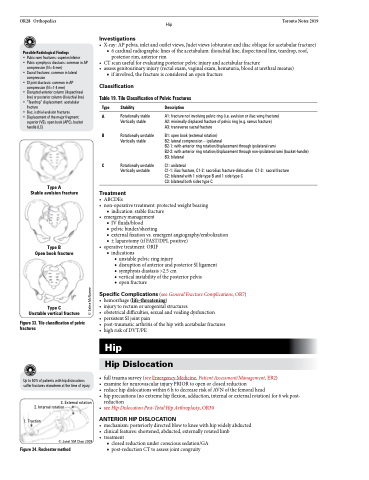Page 962 - TNFlipTest
P. 962
OR28 Orthopedics
Hip Toronto Notes 2019
Investigations
• X-ray:APpelvis,inletandoutletviews,Judetviews(obturatorandiliacobliqueforacetabularfracture) ■ 6 cardinal radiographic lines of the acetabulum: ilioischial line, iliopectineal line, teardrop, roof,
posterior rim, anterior rim
• CTscanusefulforevaluatingposteriorpelvicinjuryandacetabularfracture
• assessgenitourinaryinjury(rectalexam,vaginalexam,hematuria,bloodaturethralmeatus)
■ if involved, the fracture is considered an open fracture
Classification
Table 19. Tile Classification of Pelvic Fractures
Possible Radiological Findings
• Pubic rami fractures: superior/inferior
• Pubic symphysis diastasis: common in AP
compression (N=5 mm)
• Sacral fractures: common in lateral
compression
• SI joint diastasis: common in AP
compression (N=1-4 mm)
• Disrupted anterior column (iliopectineal
line) or posterior column (ilioischial line)
• “Teardrop” displacement: acetabular
fracture
• Iliac, ischial avulsion fractures
• Displacement of the major fragment:
superior (VS), open book (APC), bucket handle (LC)
Type A
Stable avulsion fracture
Type B
Open book fracture
Type C Unstable vertical fracture
Figure 33. Tile classification of pelvic fractures
Hip
Hip Dislocation
• fulltraumasurvey(seeEmergencyMedicine,PatientAssessment/Management,ER2)
• examineforneurovascularinjuryPRIORtoopenorclosedreduction
• reducehipdislocationswithin6htodecreaseriskofAVNofthefemoralhead
• hipprecautions(noextremehipflexion,adduction,internalorexternalrotation)for6wkpost-
reduction
• seeHipDislocationPost-TotalHipArthroplasty,OR30
ANTERIOR HIP DISLOCATION
• mechanism:posteriorlydirectedblowtokneewithhipwidelyabducted • clinicalfeatures:shortened,abducted,externallyrotatedlimb
• treatment
■ closed reduction under conscious sedation/GA ■ post-reductionCTtoassessjointcongruity
Type Stability
A Rotationally stable Vertically stable
B Rotationally unstable Vertically stable
C Rotationally unstable Vertically unstable
Treatment
Description
A1: fracture not involving pelvic ring (i.e. avulsion or iliac wing fracture) A2: minimally displaced fracture of pelvic ring (e.g. ramus fracture)
A3: transverse sacral fracture
B1: open book (external rotation)
B2: lateral compression – ipsilateral
B2-1: with anterior ring rotation/displacement through ipsilateral rami
B2-2: with anterior ring rotation/displacement through non-ipsilateral rami (bucket-handle) B3: bilateral
C1: unilateral
C1-1: iliac fracture, C1-2: sacroiliac fracture-dislocation C1-3: sacral fracture C2: bilateral with 1 side type B and 1 side type C
C3: bilateral both sides type C
• ABCDEs
• non-operativetreatment:protectedweightbearing
■ indication: stable fracture • emergencymanagement
■ IVfluids/blood
■ pelvic binder/sheeting
■ external fixation vs. emergent angiography/embolization ■ ± laparotomy (if FAST/DPL positive)
• operativetreatment:ORIF ■ indications
◆ unstable pelvic ring injury
◆ disruption of anterior and posterior SI ligament ◆ symphysis diastasis >2.5 cm
◆ vertical instability of the posterior pelvis
◆ open fracture
Specific Complications (see General Fracture Complications, OR7) • hemorrhage(life-threatening)
• injurytorectumorurogenitalstructures
• obstetricaldifficulties,sexualandvoidingdysfunction
• persistentSIjointpain
• post-traumaticarthritisofthehipwithacetabularfractures • highriskofDVT/PE
Up to 50% of patients with hip dislocations suffer fractures elsewhere at the time of injury
3. External rotation 2. Internal rotation
1. Traction
© Janet SM Chan 2009
Figure34.Rochestermethod
© Seline McNamee


